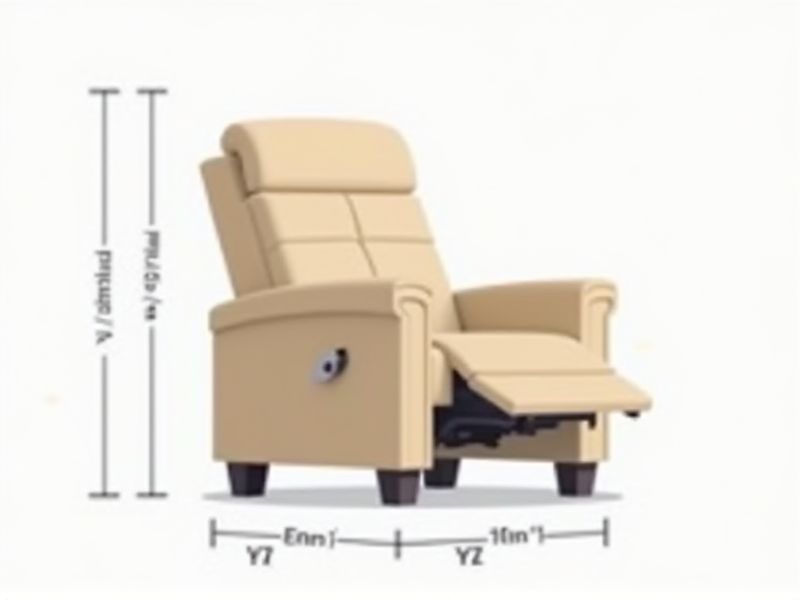
Knowing the standard dimensions of a recliner can help you choose the perfect fit for your living space and comfort needs. Most recliners range from 32 to 38 inches wide, 37 to 42 inches deep, and around 40 to 44 inches tall. For example, a common fully reclined length is about 65 to 70 inches, which should be considered for proper placement away from walls or furniture. Carefully measuring your available space and comparing it to these dimensions ensures your new recliner fits well and operates smoothly in your room.
Seat Width
When selecting a recliner, consider the seat width, which typically ranges from 20 to 25 inches, as it directly impacts your comfort and support. A wider seat can enhance your overall relaxation experience, particularly for individuals with larger body types, as it allows for better posture and reduces pressure points. For optimal ergonomics, ensure that your knees can comfortably align with the edge of the footrest while maintaining back support. A properly sized recliner will not only boost your lounging experience but also promote long-term health benefits by maintaining proper spine alignment.
Seat Depth
The ideal seat depth for recliners typically ranges from 20 to 22 inches, offering optimal comfort for most users. A depth of 21 inches is often recommended for average-sized individuals, providing ample support while seated. For those with longer legs, a deeper seat around 22 inches may enhance comfort and promote better posture. Ensuring the right seat depth is crucial for reducing strain on the lower back and enhancing relaxation during use.
Back Height
When selecting a recliner, an essential consideration is the back height, which significantly influences comfort and support. A typical back height ranges from 38 to 42 inches, catering to varied user needs and preferences. A higher back provides better support for taller individuals, ensuring proper head and neck alignment, while a lower back option often offers ease of mobility and access. Investing in a recliner with an appropriate back height can enhance your lounging experience, contributing to overall relaxation and well-being.
Arm Height
The ideal arm height for recliners typically ranges from 24 to 32 inches from the floor, ensuring comfortable support for users of various heights. Ergonomic designs prioritize armrests that align with the natural resting position of your arms, reducing strain during extended use. Many modern recliners feature adjustable armrests, offering customization for optimal comfort. When choosing a recliner, consider models that provide a balance between arm height and overall seat depth to enhance your sitting experience.
Overall Width
When selecting a recliner, the overall width is a critical factor to consider for ensuring comfort and fit in your space. Standard widths typically range from 28 to 40 inches, accommodating various body sizes and room dimensions. A wider recliner, measuring up to 40 inches, provides extra space for relaxation, while narrower options can be ideal for smaller areas. You should measure your room carefully to ensure the chosen recliner complements both your comfort needs and available space.
Overall Height
The overall height of a recliner typically ranges from 36 to 44 inches, depending on the design and style. Choosing a recliner that matches your overall height is essential for optimal comfort and support, particularly when considering lumbar and neck alignment. For individuals under 5'4", a lower-profile recliner may enhance usability, while taller individuals, over 6'1", should seek models with extended leg rests. Proper measurement ensures that your recliner not only fits your body well but also integrates seamlessly into your living space.
Seat To Footrest Distance
The seat-to-footrest distance of recliners is crucial for ensuring optimal comfort and support. A standard measurement ranges from 40 to 50 inches, accommodating various body types. Proper alignment of this distance can alleviate strain on your legs and back during extended sitting periods. Choosing a recliner with adjustable features can further enhance your experience by tailoring the fit to your specific needs.
Reclined Length
Reclined length is a crucial measurement for ensuring optimal comfort in recliners, typically ranging from 60 to 70 inches depending on the model. This dimension affects how well the recliner fits your body, providing support for your back and legs while allowing for relaxation. When selecting a recliner, consider that a standard reclined length accommodates various heights, with many designs offering adjustable settings to enhance your experience. Understanding this feature ensures that you choose a recliner tailored to your ergonomic needs, enhancing your leisure time at home.
Weight Capacity
Recliners typically have a weight capacity ranging from 250 to 400 pounds, with many models specifically designed to support heavier users. For enhanced durability, look for recliners constructed with reinforced frames and high-quality upholstery materials, which can significantly extend their lifespan. Options such as power recliners often accommodate up to 500 pounds while providing additional comfort features like heated seating and adjustable lumbar support. When selecting a recliner, ensure it meets your weight requirements to guarantee safety and comfort during use.
Legroom Space
When selecting a recliner, pay attention to the legroom space, which typically ranges from 40 to 45 inches in overall length. Optimal legroom ensures maximum comfort, allowing users between 5'3" to 6'2" to fully enjoy the reclining position without feeling cramped. Look for models with adjustable leg rests or extendable footrests, which can enhance the experience, accommodating various body sizes. Your choice in legroom directly affects relaxation quality, making it a crucial factor in your decision-making process.
